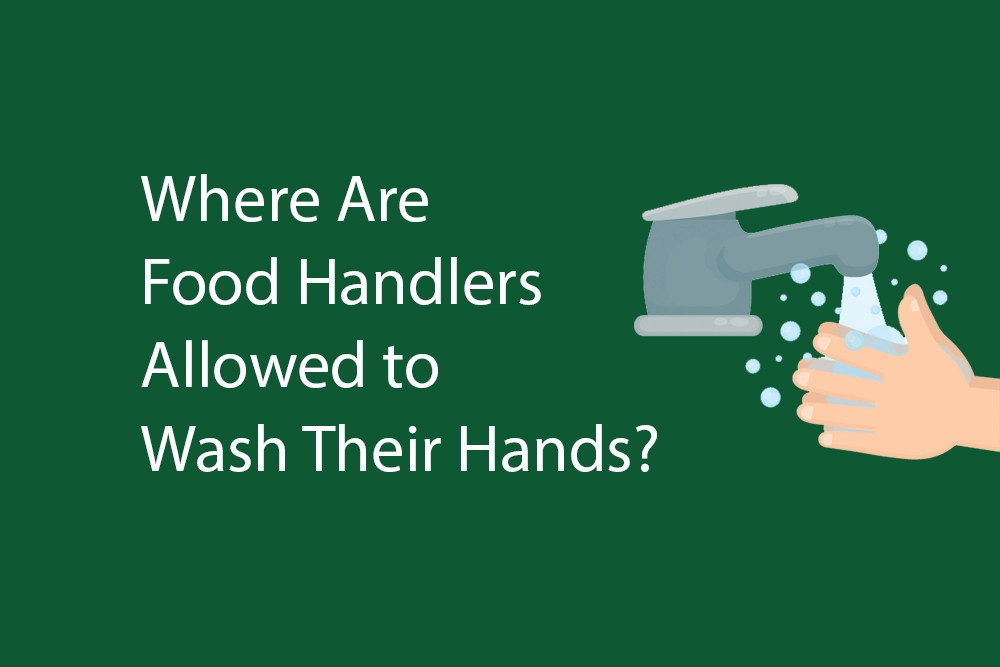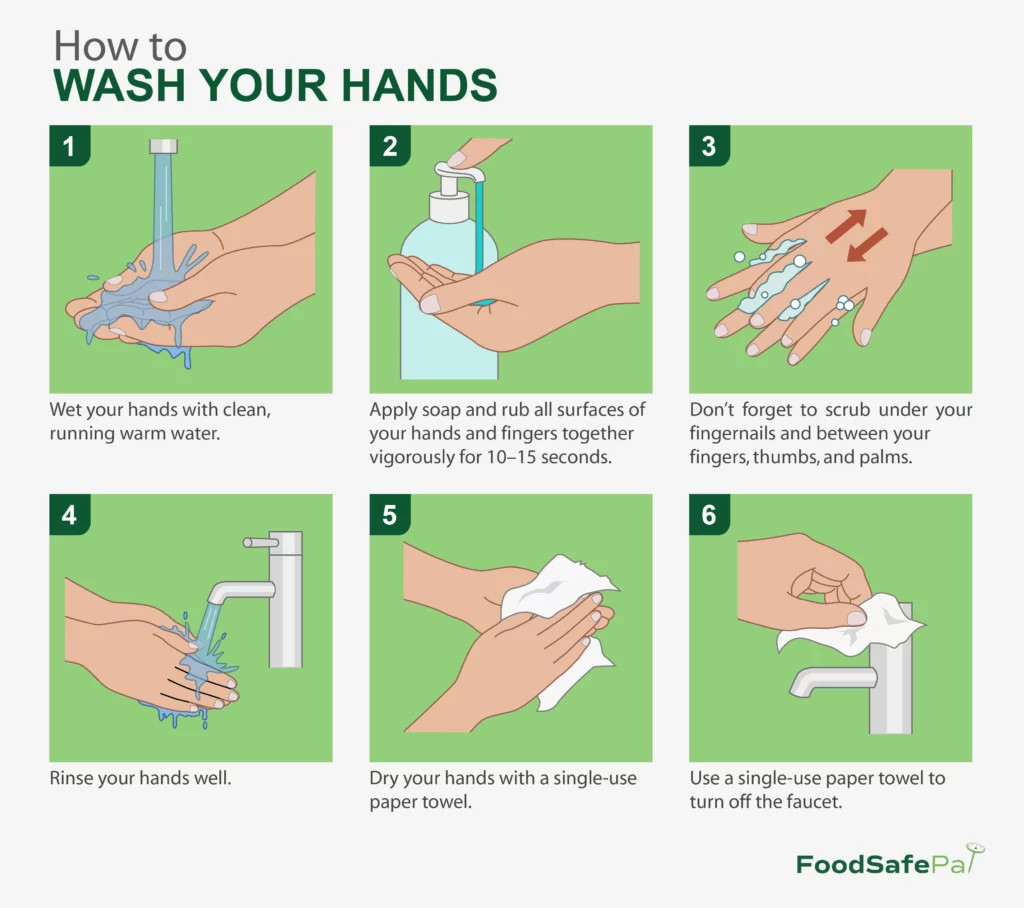Maintaining excellent hand hygiene is paramount in preventing the transmission of foodborne illnesses. Washing your hands correctly and at the right times is a crucial step for anyone handling food. However, the location of handwashing is equally important. Using the wrong sink can inadvertently spread harmful bacteria and compromise food safety.
This guide clarifies the designated areas for handwashing for food handlers, ensuring best practices are followed to protect public health.
 Designated Handwashing Sink for Food Handlers
Designated Handwashing Sink for Food Handlers
Designated Handwashing Sinks: Your Hygiene Station
The only permissible place for food handlers to wash their hands is in a designated handwashing sink. These sinks are specifically designed and equipped to facilitate proper hand hygiene. A designated sink is not just any sink; it’s a hygiene station providing all necessities for effective handwashing:
- Hot and Cold Running Water: Essential for effectively removing dirt and germs. The water temperature should be comfortably warm to encourage thorough washing without scalding.
- Soap: Liquid soap is preferred for hygiene as bar soap can harbor bacteria. It should be readily available, encouraging frequent use.
- Single-Use Paper Towels or Hand Dryer: For drying hands after washing. Single-use paper towels are highly recommended in food handling environments to minimize the risk of recontamination. Alternatively, a properly functioning hand dryer can be used.
- Waste Receptacle: For disposing of used paper towels, ideally hands-free to avoid re-contaminating hands after washing.
These designated handwashing sinks should be strategically located for easy access within food preparation, service, and dishwashing areas. Restroom sinks also qualify as designated handwashing sinks due to their provision of the necessary handwashing requirements.
It’s critical to remember that designated handwashing sinks are solely for handwashing. They should never be used for:
- Food preparation: Washing fruits, vegetables, or thawing meat.
- Dishwashing: Rinsing utensils or dishes.
- Storage: Holding cleaning supplies, utensils, or any other items.
- Disposing of waste: Such as mop water or other liquid waste.
Using handwashing sinks for unintended purposes can lead to contamination, transforming a hygiene station into a potential source of pathogens. Maintaining a clear and unobstructed path to these sinks is also vital, ensuring they are readily accessible whenever needed.
Sinks to Avoid: Preventing Cross-Contamination
Conversely, several types of sinks are strictly prohibited for handwashing by food handlers. These include:
- Food Preparation Sinks: These sinks are exclusively for washing and preparing food items. Washing hands in these sinks introduces the risk of cross-contamination, transferring bacteria from hands to food that is meant to be cleaned or is ready to be consumed.
- Dishwashing Sinks: These sinks are designed for cleaning dirty dishes and utensils. They are often filled with soapy water and food debris, making them highly unsanitary for handwashing. Using dishwashing sinks contaminates hands rather than cleaning them.
- Service Sinks (Mop Sinks): These sinks are used for disposing of mop water and other cleaning solutions. They are heavily contaminated with dirt and cleaning chemicals, posing a significant health risk if used for handwashing.
These sinks typically lack the necessary provisions for proper handwashing, such as soap and single-use towels, further highlighting their unsuitability for hand hygiene. Using these sinks for handwashing can directly transfer contaminants to your hands, negating the purpose of handwashing and increasing the risk of foodborne illness outbreaks.
When is Handwashing Mandatory for Food Handlers?
Handwashing isn’t just about location; it’s also about timing. As a food handler, it’s your responsibility to wash your hands every time they may have become contaminated. This includes numerous critical moments, such as:
- Upon entering food preparation areas: Start clean to maintain a hygienic environment.
- Before donning food-safe gloves: Gloves provide a barrier but clean hands underneath are essential.
- Between glove changes: Gloves can become contaminated; handwashing is needed when changing them.
- Before preparing special orders (allergies): Prevent cross-contact of allergens by washing hands thoroughly.
- Before commencing food preparation: Ensure a clean start before handling any food items.
- Before handling clean equipment and utensils: Prevent contamination of items that will touch food.
- Switching between raw and ready-to-eat foods: Avoid cross-contamination between different food categories.
- After handling soiled dishes or utensils: Clean hands are crucial after contact with dirty items.
- After touching your face, hair, or body: Everyday actions can transfer germs to your hands.
- After coughing, sneezing, or blowing your nose: Respiratory droplets are a major source of contamination.
- After eating, drinking, or smoking: These activities can contaminate hands.
- After handling service animals or aquatic animals: Animals can carry various pathogens.
- After using the restroom: This is a critical handwashing point to prevent fecal-oral contamination.
Neglecting to wash your hands at these critical junctures can lead to the transfer of bacteria, viruses, and other pathogens to food, food contact surfaces, and ultimately, to consumers. Consistent and timely handwashing is a cornerstone of food safety.
The Six Steps to Effective Handwashing
Knowing where and when to wash your hands is only part of the equation. How you wash your hands is equally vital. Rushing through the process or skipping steps renders handwashing ineffective, leaving harmful microorganisms on your hands.
Follow these six essential steps for proper handwashing technique:
- Wet your hands: Use clean, running warm water to wet your hands thoroughly.
- Apply soap: Dispense an adequate amount of liquid soap to cover all hand surfaces.
- Lather and scrub: Vigorously rub your hands together, creating a lather and scrubbing all surfaces, including:
- Palms and backs of hands
- Between fingers
- Under fingernails
- Thumbs
Do this for at least 10-15 seconds. A helpful tip is to hum the “Happy Birthday” song twice to ensure you scrub for long enough.
- Rinse thoroughly: Rinse your hands well under clean, running water, ensuring all soap residue is removed.
- Dry your hands: Dry your hands completely using a single-use paper towel.
- Turn off the faucet with a paper towel: Use a clean paper towel to turn off the faucet to prevent re-contaminating your freshly washed hands.
 Proper Handwashing Steps for Food Handlers
Proper Handwashing Steps for Food Handlers
The entire handwashing process, from wetting hands to drying and turning off the faucet, should take a minimum of 20 seconds. If using a restroom sink behind a closed door, use a paper towel to open the door handle after washing to avoid recontamination. Many modern handwashing sinks are foot-operated or sensor-activated, minimizing hand contact with faucets.
Conclusion: Handwashing Location is Key to Food Safety
In summary, designated handwashing sinks are the only acceptable locations for food handlers to wash their hands. These sinks are specifically equipped with soap, warm water, and single-use towels to facilitate proper hygiene. Avoid using food preparation sinks, dishwashing sinks, or service sinks for handwashing to prevent cross-contamination.
Remember, frequent and thorough handwashing at the right locations and times is not just a requirement; it’s a fundamental responsibility for every food handler. By adhering to these guidelines, you play a crucial role in safeguarding public health and preventing foodborne illnesses. Prioritize hand hygiene – it’s the simplest yet most effective way to ensure food safety.

